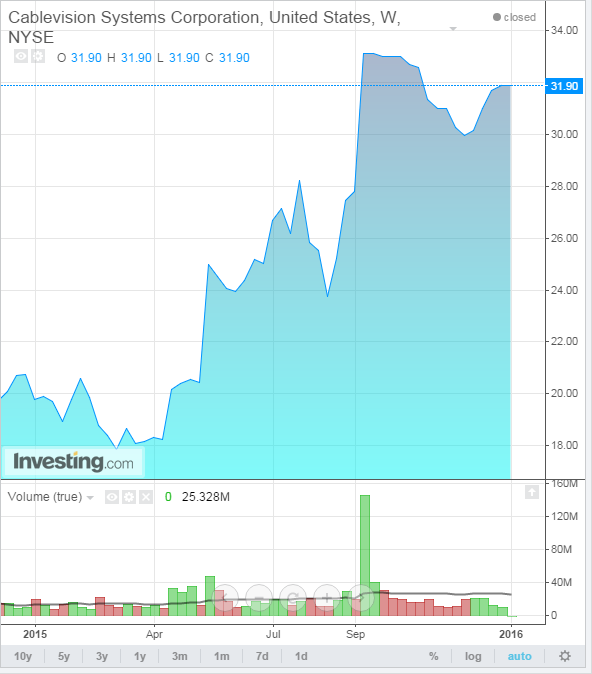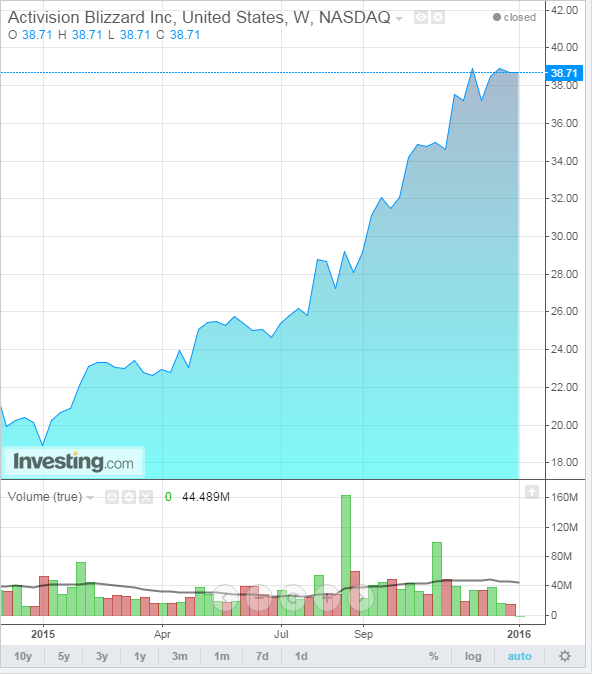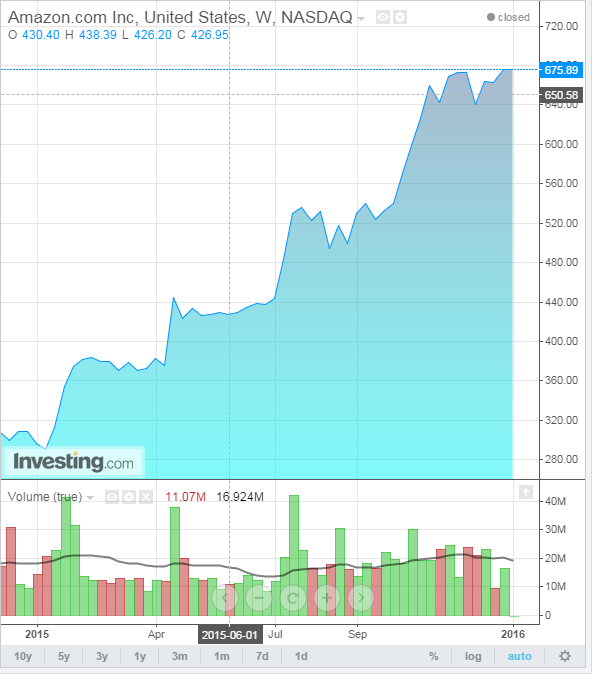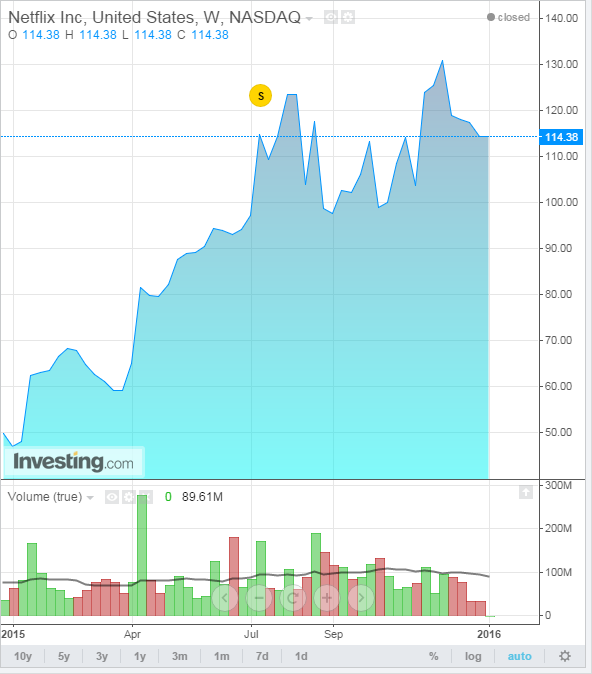by Clement Thibault
During a year when the S&P 500 stagnated, closing at a -0.73% deficit on the year, a few companies defied markets, posting extraordinary gains to reach new highs along with record growth, despite high volatility and economic uncertainty.
Here are the five strongest performers from the past year:
5: Cablevision Systems Corporation
- Opening price on January 2nd 2015: $20.77
- Opening price on December 31st 2015: $31.86
- Gains: +$11.09, +53%
- Sector: Services
Cablevision (N:CVC) is the fifth largest cable systems provider as well as the ninth largest television provider in the United States. Its shares soared in September after Netherlands-based multinational telecom company Altice NV (AS:ATCA) confirmed its plan to buy Cablevision for about $10 billion, or $34.9 a share, in an effort to enter the US telecom market. Cablevision's revenues have largely stagnated over the past few years, hovering between $6.1 and $6.4 billion, making it a stable and reasonably priced acquisition. The acquisition follows the failure of Altice to buy Time Warner Cable (N:TWC), which was acquired on May 26th by Charter Communications (O:CHTR) in a $55 billion deal. The Cablevision deal is expected to go through during 2016, although the Wall Street Journal has reported that the acquisition could face regulatory hurdles in New York. Nonetheless, the reported acquisition has driven up share prices, widely benefiting Cablevision's existing shareholders.

4: Nvidia Corporation
- Opening price on January 2nd 2015: $20.13
- Opening price on December 31st 2015: $33.39
- Gains: +$13.26, +65%
- Sector: Technology
NVIDIA (O:NVDA) is an American technology company that manufactures graphics processing units for computers, as well as chip unit systems for the ever-growing mobile computing market. Nvidia produces the very popular GeForce series graphic cards which are used mainly among gamers, as well as Quadro series cards, designed for graphics professionals. The company recently lost a patent lawsuit against competitors Samsung (KS:005930) and Qualcomm (O:QCOM), but it reported good revenue growth for its second and third quarters and the stock price has been moving up throughout the year. Nvidia also climbed on reports that its market share has grown from 60% in Q2 2014 to 80% in Q3 2015, as main rival Advanced Micro Devices (O:AMD) continues to struggle with besting the immense popularity of Nvidia's GTX970 graphics card. As the clear market leader, Nvidia is primed for another year of dominance in its field.

3: Activision Blizzard
- Opening price on January 2nd 2015: $20.24
- Opening price on December 31st 2015: $39.43
- Gains: +$19.19, +94%
- Sector: Technology
Activision Blizzard (O:ATVI) is one of only three American gaming companies listed on the S&P 500 alongside Electronic Arts (O:EA) and, surprisingly, Microsoft (O:MSFT). The 2007 merger of Activision and Blizzard created the fifth largest gaming company in the world, based on revenues of $2.3 billion, which puts it behind Electronic Arts, Microsoft, Sony (N:SNE) and the Chinese holding company Tecent. On August 28 of this year, Activision Blizzard was added to the S&P 500 on August 28 of this year. Popular gaming titles produced by the company include the Call of Duty series which has topped $10 billion in sales in its 12 years of existence, as well as World of Warcraft, the most popular massive-multiplayer online role-playing game (MMORPG) on the market, with 5.5 million monthly subscribers, making it currently the world’s most subscribed MMORPG. Activision Blizzard has announced the formation of a film studio dedicated to creating original content brand extensions such as a Call of Duty movie, likely to be ready in 2018 or 2019 according to co-president Nick van Dyk, as part of an effort to capitalize on the popularity of its games.

2: Amazon.com
- Opening price on January 2nd 2015: $312.58
- Opening price on December 31st 2015: $689.07
- Gains: +$376.49, +120%
- Sector: Services
Amazon (O:AMZN) is the largest internet-based retailer in the United States, with a $323 billion market cap, significantly higher than the largest bricks-and-mortar retailer in the world, Wal-Mart (N:WMT), whose market cap is just $196 billion. What started as an online bookstore in 1994, has become a behemoth selling everything from groceries to electronics, as well as its own line of products—Kindle Cloud readers and Kindle Fire cloud readers. AMZN is also the world’s largest provider of cloud-based infrastructure services. Although its operating income is marginal, from 2011 to 2014 Amazon's revenue almost doubled, to a staggering $89 billion dollars. Its Amazon Prime membership service grew substantially over the recent holiday period, with 3 million new members. Overall, the company is expected to continue its stellar growth in 2016. Although Amazon is known to reinvest income in its business, it carries a gigantic Price-to-Earnings ratio of 980; The estimated, average P/E of the S&P 500 stands at 21.54, according to multpl.com. While there is certainly more room for growth, investors should be wary of Amazon. It is currently priced based on a very aggressive expectation of continued growth, which may be unsustainable.

1: Netflix
- Opening price on January 2nd 2015: $49.15 (Adjusted price based on 7:1 split effective July 15th)
- Opening price on December 31st 2015: $116.71
- Gain: +$67.56, +137%
- Sector: Services
Netflix (O:NFLX) is a multinational provider of on-demand internet streaming media. The company was started in 1997 when co-founder Reed Hastings was charged an overdue fine of $40 by a video store for a VHS copy of the movie Apollo 13. Since then, the company has specialized in renting entertainment—content, originally delivered via the USPS on a single rental basis, and later through a monthly subscription program. In 2007 the company introduced streaming video via the internet, and it has never looked back. Netflix's revenue is expected to top $6 billion in 2015, a 10% increase over 2014. NFLX has famously—and successfully—ventured into the content production world, creating such Emmy winning series as House of Cards and Orange is the New Black, which have served to bring yet more subscribers to the company. As of October 2015, the company reported 69 million subscribers; It operates in 50 countries. Much like Amazon, however, Netflix has been trading at an elevated P/E of 305, and that's only after a 7:1 stock split which occurred on July 15th. The split took the stock price down from $686 a share. With a current market cap of almost $50 billion, Netflix and its shareholders were clearly the market winners in 2015.

